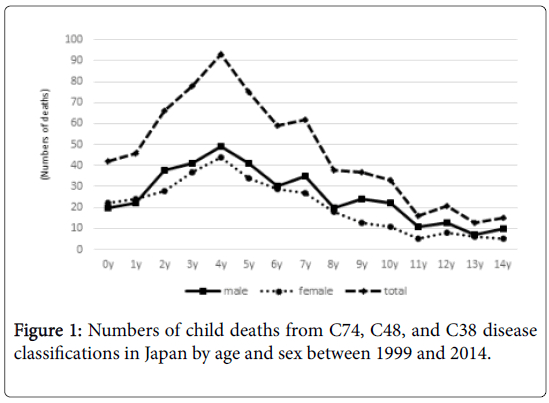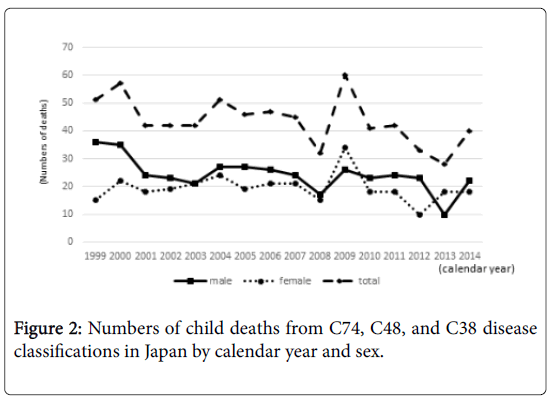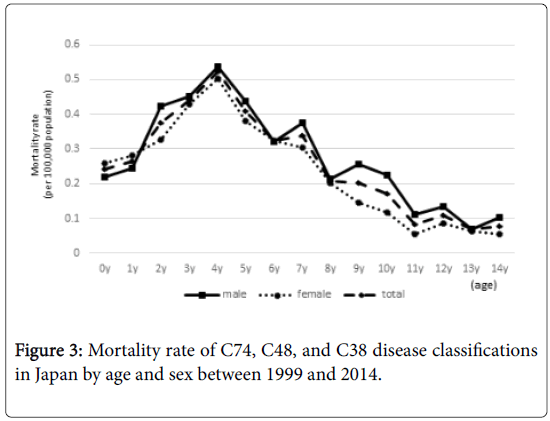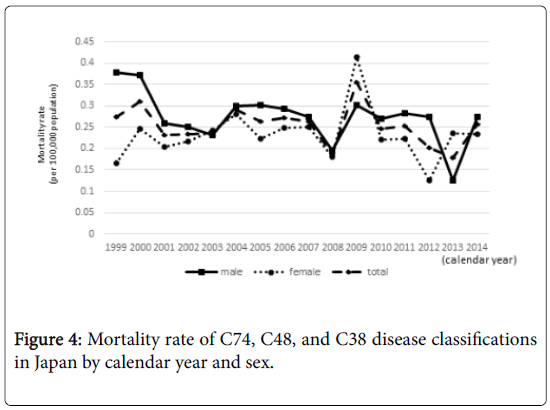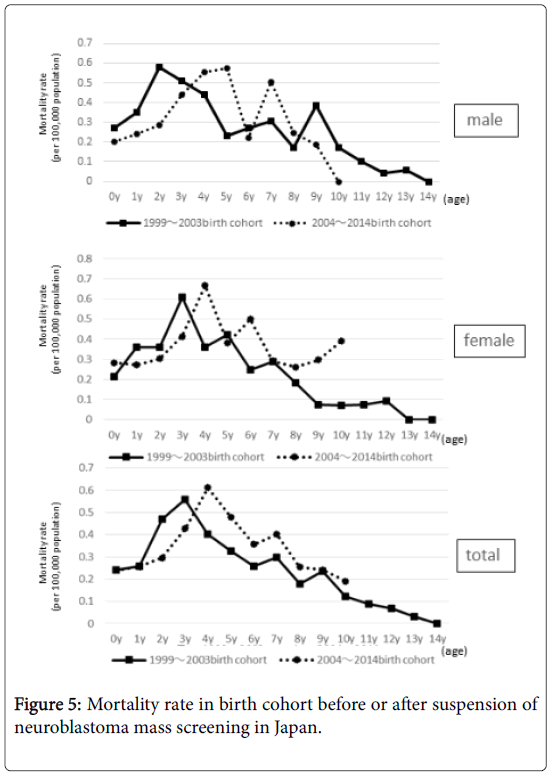Analysis of Neuroblastoma Mortality Rates before and after the Cessation of the Mass Screening Program According to Vital Statistics of Japan Data
Received: 20-Apr-2017 / Accepted Date: 26-Apr-2017 / Published Date: 28-Apr-2017 DOI: 10.4172/2161-1165.1000305
Abstract
Background: Although neuroblastoma (NB) is one of the most common neoplasms in children, the Ministry of Health, Labour, and Welfare opted to halt the mass screening program for NB at 6 months of age in 2004. It is important to determine the impact of this cessation on NB mortality.
Methods: We conducted a retrospective survey of patients with neuroblastoma as descriptive epidemiology. Mortality rates of NB below 15 years of age were observed using vital statistics data in Japan, covering the period from 1999 through 2014. We observed deaths classified as C74.9, C38.1, C38.2, C38.3, and C48.0 in our analysis, because NB does not have a unique code according to the ICD-10th classification system.
Results: A total of 631 deaths, an average of 45 per year, were recorded for children under 14 in the 16-year study period. This comprised 356 males and 275 females, giving a male to female ratio of 1.29. Both sexes showed a peak in deaths at age 4, after which mortality declined. The annual transition in mortality rate was not markedly different from the annual transition in number of deaths. We compared 2 birth cohort groups: one from 1999 to 2003, in which children had undergone mass screening, to one from 2004 to 2014, in which they had not, and found no marked difference between the two cohorts.
Conclusions: Our results indicate no overall increase in the child neuroblastoma mortality rate in childhood as a result of cessation of the mass screening program.
Keywords: Neuroblastoma; Mass screening; Mortality; Descriptive epidemiology; Japan
166005Introduction
Neuroblastoma (NB) is one of the most common neoplasms in children. In 1984, Japan became the only country to adopt mass screening for NB at 6 months of age as a national policy. By 2003, there was evidence [1-5], that this program resulted in over diagnosis of NB and insufficient evidence that it reduced the rate of death from NB. Consequently, the Ministry of Health, Labour, and Welfare opted to halt the program in 2004 [6].
Katanoda et al. [7] analyzed the secular trends in NB mortality by utilizing vital statistics data from 1980 through 2006. They reported that no significant increase in the NB mortality rate was detected after the cessation of the mass screening program in Japan. Ioka et al. [8] similarly reported no increase in NB mortality after program cessation, in this case, using data from the population-based Osaka Cancer Registry.
Shinagawa et al. [9] investigated the incidence, mortality, and survival rates of NB cases before and after screening cessation using population-based data from the cancer registry and vital statistics in Japan. They reported that the NB incidence rate decreased markedly and the mortality rate did not substantially change after screening was discontinued, and concluded that the NB mass screening program probably caused over diagnosis, and its effectiveness was not clear. The existing studies considered only neoplasms from a single anatomical site and the data may therefore not accurately represent overall NB mortality.
In this report, we analyzed trends in deaths from adrenal, retroperitoneal, andmediastinal malignant neoplasms using vital statistics data from 1999 through 2014. This study investigated the effects of the suspension of mass screening for neuroblastoma in infants in Japan on mortality rates from the disease. We found no increase in mortality after cessation of the screening program. We believe that our study makes a significant contribution to the literature.
Materials and Methods
We conducted a retrospective survey of patients with neuroblastoma as descriptive epidemiology. We analyzed death data from vital statistics in Japan, which were based on death certificates written by physicians. The subjects were classified as C74.9, C38.1, C38.2, C38.3, and C48.0 in the International Classification of Diseases 10th Revision (ICD-10th). The period covered was from 1999 (the year of introduction of the 10th and current revision of the International Classification of Diseases (ICD-10th)) through 2014 (the latest available year). The data was obtained by application under Article 33 of the Statistics Act (Article 33 of the Statistics Act, which allows provision of census data for research purposes).
In the Vital Statistics, causes of death are classified according to ICD-10, which groups malignant neoplasms according to anatomical site. There is no specific code for NB; if, we instead included the following disease classifications to assess NB mortality rate: C74.9 (malignant neoplasm of the adrenal gland, unknown site), C38.1 (malignant neoplasm of the heart, mediastinum and pleura, anterior mediastinal malignancy), C38.2 (cardiac, mediastinal and pleural malignant neoplasms, posterior mediastinal malignancy), C38.3 (cardiac, mediastinal and pleural malignant neoplasms, mediastinum), and C48.0 (retroperitoneal and malignant neoplasm of the peritoneum, retroperitoneum).
Because the number of deaths from these diseases is presented according to sex and age, mortality was separately calculated for each group.
The denominator used for calculating the mortality rate was the population for each sex and age in each year studied used in the vital statistics. As deaths are divided into every year of age but population is divided into 5-year groups, the population for each age is determined as a fifth of the age group population.
Additionally, the population was divided into 2 birth cohorts-that born before the cessation of the screening program, and those born after-and mortality rate was similarly calculated for these 2 groups.
Ethical considerations: This research exclusively used previously collected Vital Statistics data, and therefore there are no ethical implications to consider.
Results
A total of 631 deaths from NB-associated conditions (an average of 45 people per year) were recorded in children aged 0-14 years between 1999 and 2014 (Table 1).
| Calendar year | Sex | Age-specific number of cases | |||||||||||||||
|---|---|---|---|---|---|---|---|---|---|---|---|---|---|---|---|---|---|
| 0 | 1 | 2 | 3 | 4 | 5 | 6 | 7 | 8 | 9 | 10 | 11 | 12 | 13 | 14 | 0-14 | ||
| 1999 | male | 3 | 5 | 3 | 1 | 6 | 4 | 2 | 3 | 1 | 1 | 3 | 2 | 2 | 0 | 0 | 36 |
| female | 2 | 0 | 1 | 1 | 2 | 3 | 2 | 1 | 1 | 0 | 0 | 0 | 1 | 0 | 1 | 15 | |
| total | 5 | 5 | 4 | 2 | 8 | 7 | 4 | 4 | 2 | 1 | 3 | 2 | 3 | 0 | 1 | 51 | |
| 2000 | male | 1 | 3 | 4 | 4 | 5 | 4 | 4 | 3 | 2 | 1 | 2 | 0 | 1 | 1 | 0 | 35 |
| female | 2 | 2 | 3 | 1 | 3 | 0 | 3 | 2 | 1 | 0 | 0 | 0 | 3 | 2 | 0 | 22 | |
| total | 3 | 5 | 7 | 5 | 8 | 4 | 7 | 5 | 3 | 1 | 2 | 0 | 4 | 3 | 0 | 57 | |
| 2001 | male | 1 | 1 | 4 | 2 | 2 | 1 | 0 | 3 | 0 | 1 | 1 | 3 | 1 | 0 | 4 | 24 |
| female | 0 | 4 | 3 | 1 | 2 | 2 | 0 | 2 | 1 | 1 | 0 | 2 | 0 | 0 | 0 | 18 | |
| total | 1 | 5 | 7 | 3 | 4 | 3 | 0 | 5 | 1 | 2 | 1 | 5 | 1 | 0 | 4 | 42 | |
| 2002 | male | 3 | 1 | 1 | 4 | 2 | 5 | 2 | 1 | 2 | 0 | 2 | 0 | 0 | 0 | 0 | 23 |
| female | 0 | 3 | 4 | 1 | 3 | 4 | 0 | 2 | 1 | 0 | 1 | 0 | 0 | 0 | 0 | 19 | |
| total | 3 | 4 | 5 | 5 | 5 | 9 | 2 | 3 | 3 | 0 | 3 | 0 | 0 | 0 | 0 | 42 | |
| 2003 | male | 0 | 1 | 2 | 3 | 1 | 1 | 4 | 1 | 1 | 3 | 1 | 0 | 2 | 0 | 1 | 21 |
| female | 2 | 1 | 1 | 3 | 3 | 1 | 1 | 3 | 2 | 0 | 1 | 0 | 1 | 1 | 1 | 21 | |
| total | 2 | 2 | 3 | 6 | 4 | 2 | 5 | 4 | 3 | 3 | 2 | 0 | 3 | 1 | 2 | 42 | |
| 2004 | male | 1 | 3 | 6 | 4 | 2 | 1 | 4 | 1 | 0 | 1 | 1 | 0 | 2 | 0 | 1 | 27 |
| female | 1 | 0 | 0 | 8 | 2 | 4 | 3 | 2 | 0 | 2 | 1 | 0 | 0 | 0 | 1 | 24 | |
| total | 2 | 3 | 6 | 12 | 4 | 5 | 7 | 3 | 0 | 3 | 2 | 0 | 2 | 0 | 2 | 51 | |
| 2005 | male | 0 | 2 | 4 | 1 | 5 | 1 | 3 | 3 | 3 | 0 | 0 | 3 | 2 | 0 | 0 | 27 |
| female | 3 | 2 | 2 | 3 | 2 | 3 | 1 | 1 | 1 | 0 | 1 | 0 | 0 | 0 | 0 | 19 | |
| total | 3 | 4 | 6 | 4 | 7 | 4 | 4 | 4 | 4 | 0 | 1 | 3 | 2 | 0 | 0 | 46 | |
| 2006 | male | 1 | 4 | 5 | 3 | 2 | 3 | 2 | 0 | 2 | 2 | 2 | 0 | 0 | 0 | 0 | 26 |
| female | 2 | 3 | 2 | 2 | 0 | 3 | 1 | 0 | 2 | 3 | 2 | 0 | 1 | 0 | 0 | 21 | |
| total | 3 | 7 | 7 | 5 | 2 | 6 | 3 | 0 | 4 | 5 | 4 | 0 | 1 | 0 | 0 | 47 | |
| 2007 | male | 1 | 0 | 3 | 4 | 3 | 0 | 0 | 4 | 0 | 2 | 4 | 0 | 0 | 1 | 2 | 24 |
| female | 3 | 4 | 1 | 2 | 3 | 2 | 1 | 2 | 0 | 2 | 0 | 1 | 0 | 0 | 0 | 21 | |
| total | 4 | 4 | 4 | 6 | 6 | 2 | 1 | 6 | 0 | 4 | 4 | 1 | 0 | 1 | 2 | 45 | |
| 2008 | male | 1 | 0 | 0 | 2 | 4 | 2 | 2 | 1 | 0 | 2 | 1 | 0 | 0 | 2 | 0 | 17 |
| female | 1 | 0 | 2 | 1 | 4 | 0 | 1 | 3 | 1 | 1 | 1 | 0 | 0 | 0 | 0 | 15 | |
| total | 2 | 0 | 2 | 3 | 8 | 2 | 3 | 4 | 1 | 3 | 2 | 0 | 0 | 2 | 0 | 32 | |
| 2009 | male | 2 | 4 | 1 | 3 | 1 | 1 | 1 | 2 | 4 | 2 | 1 | 0 | 1 | 1 | 2 | 26 |
| female | 4 | 1 | 5 | 7 | 3 | 5 | 3 | 2 | 1 | 1 | 0 | 0 | 0 | 1 | 1 | 34 | |
| total | 6 | 5 | 6 | 10 | 4 | 6 | 4 | 4 | 5 | 3 | 1 | 0 | 1 | 2 | 3 | 60 | |
| 2010 | male | 1 | 1 | 1 | 2 | 4 | 4 | 1 | 2 | 0 | 4 | 2 | 0 | 1 | 0 | 0 | 23 |
| female | 0 | 0 | 0 | 1 | 4 | 2 | 5 | 1 | 2 | 0 | 0 | 1 | 0 | 1 | 1 | 18 | |
| total | 1 | 1 | 1 | 3 | 8 | 6 | 6 | 3 | 2 | 4 | 2 | 1 | 1 | 1 | 1 | 41 | |
| 2011 | male | 1 | 0 | 0 | 4 | 5 | 3 | 0 | 6 | 1 | 2 | 1 | 0 | 0 | 1 | 0 | 24 |
| female | 0 | 1 | 1 | 0 | 5 | 2 | 4 | 2 | 1 | 0 | 1 | 0 | 0 | 1 | 0 | 18 | |
| total | 1 | 1 | 1 | 4 | 10 | 5 | 4 | 8 | 2 | 2 | 2 | 0 | 0 | 2 | 0 | 42 | |
| 2012 | male | 3 | 0 | 3 | 4 | 2 | 3 | 1 | 2 | 3 | 1 | 0 | 0 | 1 | 0 | 0 | 23 |
| female | 0 | 0 | 1 | 3 | 2 | 0 | 0 | 1 | 1 | 0 | 0 | 0 | 2 | 0 | 0 | 10 | |
| total | 3 | 0 | 4 | 7 | 4 | 3 | 1 | 3 | 4 | 1 | 0 | 0 | 3 | 0 | 0 | 33 | |
| 2013 | male | 1 | 1 | 0 | 0 | 0 | 0 | 3 | 1 | 1 | 1 | 1 | 0 | 0 | 1 | 0 | 10 |
| female | 1 | 1 | 1 | 1 | 3 | 3 | 3 | 1 | 1 | 1 | 1 | 1 | 0 | 0 | 0 | 18 | |
| total | 2 | 2 | 1 | 1 | 3 | 3 | 6 | 2 | 2 | 2 | 2 | 1 | 0 | 1 | 0 | 28 | |
| 2014 | male | 0 | 1 | 1 | 0 | 5 | 8 | 1 | 2 | 0 | 1 | 0 | 3 | 0 | 0 | 0 | 22 |
| female | 1 | 2 | 1 | 2 | 3 | 0 | 1 | 2 | 2 | 2 | 2 | 0 | 0 | 0 | 0 | 18 | |
| total | 1 | 3 | 2 | 2 | 8 | 8 | 2 | 4 | 2 | 3 | 2 | 3 | 0 | 0 | 0 | 40 | |
| 1999-2014 | male | 20 | 22 | 38 | 41 | 49 | 41 | 30 | 35 | 20 | 24 | 22 | 11 | 13 | 7 | 10 | 388 |
| female | 22 | 24 | 28 | 37 | 44 | 34 | 29 | 27 | 18 | 13 | 11 | 5 | 8 | 6 | 5 | 311 | |
| total | 42 | 46 | 66 | 78 | 93 | 75 | 59 | 62 | 38 | 37 | 33 | 16 | 21 | 13 | 15 | 699 | |
Table 1: Numbers of child deaths from C74, C48, and C38 disease classifications between 1999 and 2014.
This comprised 356 males and 275 females, yielding a male to female ratio of 1.29. By year, 2009 had the greatest number of deaths at 60, followed by 57 in 2000. The lowest was 32 in 2008, followed by 33 in 2012.
Deaths peak at the age of 4 in both sexes, after which they decline (Figure 1).Examination of the annual transition in the number of deaths by sex showed an overall decline, with the exception of a temporary increase in females and overall in 2009 (Figure 2).
The mortality rates peaked at the age of 4 in both sexes, after which they decline (Figure 3), similar to number of deaths. The annual transition in the mortality rate by sex showed an overall decline, with the exception of a temporary increase in females and overall in 2009 (Figure 4), similar to number of death.
Although the population declined due to the declining birthrate in the 14 years we observed, the annual transition of the mortality rate was not markedly different from the annual transition of number of deaths.
Comparison between 2 birth cohorts, one from 1999 through 2003 and the other from 2004 through 2014, showed no marked difference between those born before and after cessation of the NB mass screening program (Figure 5).
Discussion
Due to the evidence 1-5 that screening for NB at 6 months of age led to overdiagnosis, and insufficient evidence that it reduced the death rate from NB, the Ministry of Health, Labour, and Welfare halted the program in 2004 in Japan. 6 Thereafter, a number of studies [7-10] attempted to assess the impact of this decision. It is important to determine the impact of this cessation on neuroblastoma mortality.
Hisashige et al. [10] reported a comparison of NB incidence and mortality after 6 months of age between screened children and nonscreened children. It was conducted on children born between 1984 and 1997 in 25 areas. They suggested that NB screening contributed to a reduction in mortality from NB in Japan, as well as an increase in early stage detection of NB and a decrease in advanced stage detection. However, other studies have pointed out potential selection and information biases in this analysis [9].
In contrast, Katanoda et al. [7] analyzed nationwide NB mortality and reported that the rate did not increase after the cessation of the mass screening program in Japan. However, the disadvartage of this study was that the observed period of time was short. Ioka et al. [8] likewise reported that a significant increase in NB mortality was not observed after the cessation of the NB mass screening program in Osaka. Although their study covered long observation period, that was done in only one prefecture of Japan. In this study, we analyzed death data from vital statistics in Japan from 1999 through 2014. This time period was selected as it spanned from 1999 (the year of introduction of the 10th and current revision of the International Classification of Diseases (ICD-10th)) through 2014 (the latest available year). NB does not have a unique code according to the ICD-10th classification system. This is because malignant neoplasms are grouped according to anatomical location and NB appears not only in the adrenal gland, but also in the mediastinum and retroperitoneum [11]. Katanoda et al. [7] reported a high correlation between the number of deaths from NB and the number of deaths from adrenal gland cancer. They analyzed the secular trends in NB mortality by using cancer of the adrenal gland as a surrogate, and concluded that no significant increase in the NB mortality rate was detected after the cessation of the mass screening program in Japan. It is also important to count the deaths of NB arising from sites other than the adrenal glands. Therefore it was necessary to include deaths classified as C74.9 (malignant neoplasm of the adrenal gland, unknown site), C38.1 (malignant neoplasm of the heart, mediastinum and pleura, anterior mediastinal malignancy), C38.2 (cardiac, mediastinal and pleural malignant neoplasms, posterior mediastinal malignancy), C38.3 (cardiac, mediastinal and pleural malignant neoplasms, mediastinum), and C48.0 (retroperitoneal and malignant neoplasm of the peritoneum, retroperitoneum) in our analysis. In this report, we observed NB death for long period of time (16 years). There was no markedly change in number of NB death and mortality rate due to NB after the cessation of mass screening. Furthermore, comparison between 2 birth cohorts, one from 1999 through 2003 and the other from 2004 through 2014, showed no marked difference between those born before and after cessation of the NB mass screening program. Although the NB mass screening was suspended on 2004, we found no marked change across the years. In one of the previous studies, the cumulative NB mortality rate up to 5 years old in Osaka, was 3.65 per 100,000 children born in 1988-2003, and 1.28 per 100,000 children born in 2004-2005 [8]. In another previous study, cumulative mortality rate for adrenal gland cancer up to 5 years old, before and after the cessation of neuroblastoma mass screening program in the five prefectures (Yamagata, Niigata, Fukui, Shiga and Nagasaki), was 1.86 per 100,000 children born in 1993-2003, and 1.84 per 100,000 children born in 2004-2006 [9]. Therefore, it can be concluded that the suspension of mass screening has had insufficient impact to be evident in mortality statistics.The exception to this overall trend was the observed increase in female and overall deaths in 2009, however, in past reports, 8, 9 this trend has not been pointed out. We consider further analysis may be required to comprehensively assess the effects of mass screening suspension. We are going to make further observations, in light of the increase in death rate in 2009. In this report, the mortality of neuroblastoma was discussed as a descriptive study, and no statistical treatment was done. Actually there are some limitations. First, clinical symptoms are not considered, as we used encoded classification for analysis. Second,because the neuroblastoma does not have a unique code according to the ICD-10th classification system, the sum of data in C74.9, C38.1, C38.2, C38.3, and C48.0 were calculated. Therefore, it is undeniable that C74.9, C38.1, C38.2, C38.3, and C48.0 may include a small number of patients who are not neuroblastoma. Although there are various limitations, Based on these results, we conclude that it is reasonable to believe that childhood NB mortality has not increased as a result of cessation of the mass screening program. However, in light of the increase in death rate in 2009, we consider further observation necessary. In conclusion, our results indicate no overall increase in the child neuroblastoma mortality rate in childhood as a result of cessation of the mass screening program.
Acknowledgement
This survey was partly financially supported by the Study on effective implementation of screening and health examination based on disease epidemiology of infants (AMED).
References
- Schilling FH, Spix C, Berthold F, Erttmann R, Fehse N, et al.( 2002) Neuroblastoma screening at one year of age. N Engl J Med 346:1047-1053.
- Woods WG, Gao RN, Shuster JJ, Robinson LL, Bernstein M, et al. (2002)Screening for infants and mortality due to neuroblastoma. N Engl J Med 346:1041-1046.
- Woods WG, Tuchman M, Robinson LL, Bernstein M, Leclerc JM, et al. (1996) A population-based study of the usefulness of screening for neuroblastoma. Lancet 348:1682-1687.
- Nishi M, Miyake H, Takeda T, Hanai J, Kikuchi Y, et al.(1997) Mass screening for neuroblastoma and mortality in birth cohorts. Int J Cancer 71:552-555.
- Ministry of Health (2003) Study group report on neuroblastoma mass screening inspection method.
- Tsubono Y, Hisamichi S (2004) A halt to neuroblastoma screening in Japan. N Engl J Med 350: 2010–2011.
- Katanoda K, Hayashi K, Yamamoto K, Sobue T (2009) Secular trends in neuroblastoma mortality before and after the cessation of national mass screening in Japan. J Epidemiol 19: 266-270.
- Ioka A, Inoue M, Yoneda A, Nakamura T, Hara J, et al. (2016) Effects of the Cessation of Mass Screening for Neuroblastoma at 6 Months of Age: A Population-Based Study in Osaka, Japan.J Epidemiol 26:179-184.
- Shinagawa T, Kitamura T, Katanoda K, Matsuda T, Ito Y, et al.(2017) The incidence and mortality rates of neuroblastoma cases before and after the cessation of the mass screening program in Japan: A descriptive study. Int J Cancer 140: 618-625.
- Hisashige A (2014) Effectiveness of nationwide screening program for neuroblastoma in Japan. Glob J Health Sci 6: 94-106.
- Hanawa Y, Sawada T, Tsunoda A (1990) Decrease in childhood neuroblastoma death in Japan. Med PediatrOncol 18: 472–475.
Citation: Makino N, Nakamura Y, Ikeda H, Oka A (2017) Analysis of Neuroblastoma Mortality Rates before and after the Cessation of the Mass Screening Program According to Vital Statistics of Japan Data. Epidemiology (Sunnyvale) 7:305. DOI: 10.4172/2161-1165.1000305
Copyright: © 2017 Makino N, et al. This is an open-access article distributed under the terms of the Creative Commons Attribution License, which permits unrestricted use, distribution, and reproduction in any medium, provided the original author and source are credited.
Select your language of interest to view the total content in your interested language
Share This Article
Recommended Journals
Open Access Journals
Article Tools
Article Usage
- Total views: 4142
- [From(publication date): 0-2017 - Aug 29, 2025]
- Breakdown by view type
- HTML page views: 3269
- PDF downloads: 873

